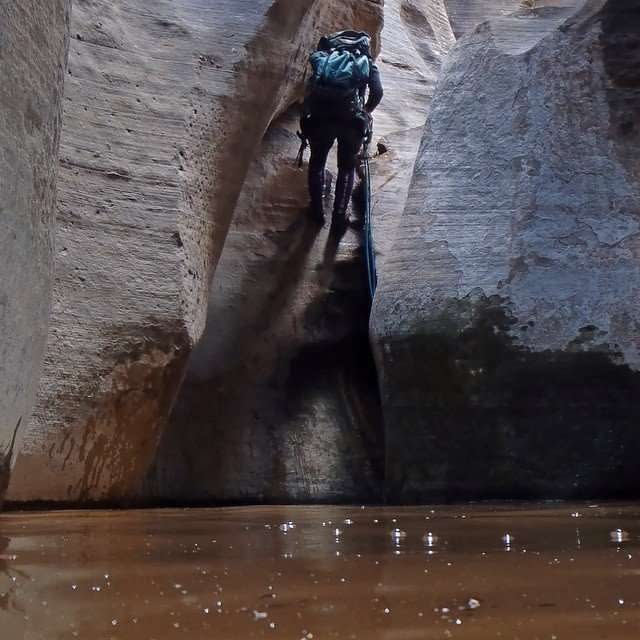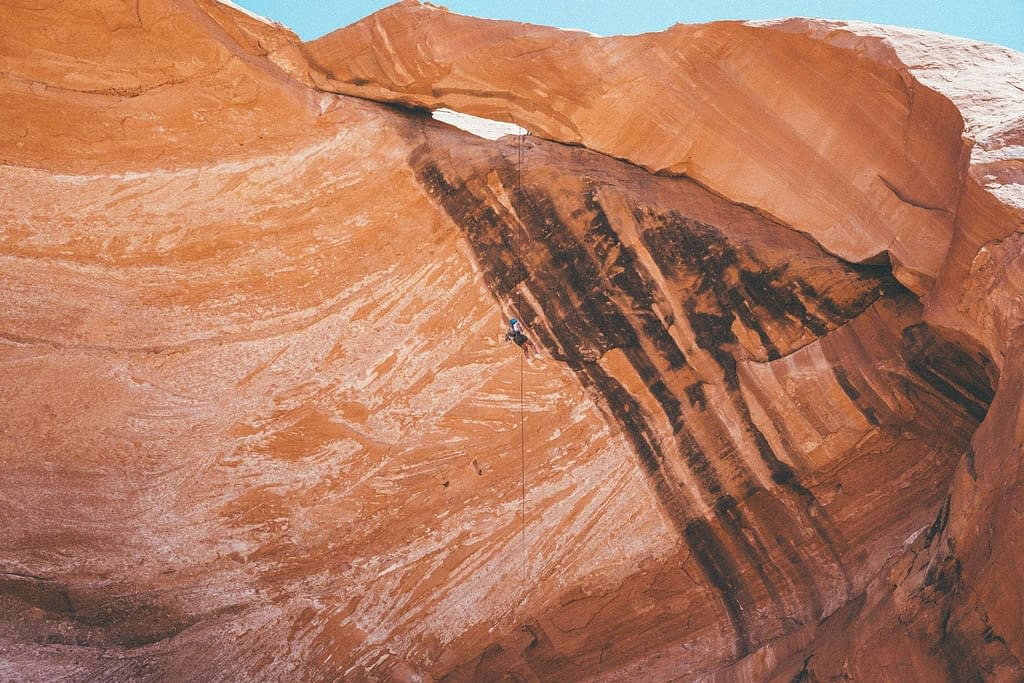A study conducted in 2007 on injury patterns among canyoneers identified the most common injuries encountered while canyoneering. The study broke down injury patterns by major and minor.


As shown in the study, many risks exist in canyons and many of them can kill you. You don’t want to die in a canyon. It’s a mess trying to recover bodies from canyons. You want to enjoy canyoneering with confidence and safety. Read on to learn how to not become the next canyoneering statistic.
Let’s discuss all the ways people get injured or die canyoneering in order of frequency.
Heat exposure and dehydration

I’m somewhat of a camel and don’t need as much water as others. One canyoneering trip in Zion National Park in July, I learned this the hard way. I was with three other guys, all of whom outweighed me by at least 50 pounds. My 3-liter pack had plenty of water, but each of the others ran out of water long before I did. I shared some water with
After a few hours of hiking cross-country out of the bottom of the canyon, we were all out of
Even with the refill, the others in my group were nearly out of
This story could have ended much differently had I not packed a water filter.
Hot hikes in and out of canyons are very common. You should prepare well for these hikes, but sometimes we underestimate the amount of water needed. Even if we do have enough water for a normal day, sometimes things don’t go as planned. You often end up in the sun much longer than anticipated. Having a backup plan for how to deal with heat and dehydration is important. Do you know how to find water in the desert? Do you carry a water filter? Also, wearing the right clothing to keep you cool and protected from the sun can go a long way. Full brimmed sun hats and long sleeve shirts can mitigate the heat and keep you from becoming a raisin.
Hypothermia

One of the more frequent and perhaps the slowest way to die in a canyon is hypothermia. Canyons can deceive us. You go in when it’s 105 degrees outside in the middle of August and pretty soon you find yourself sloshing around in a deep and shady pothole filled 45-degree water that you may not easily be able to get out of. Unless you pack wetsuits or drysuits, and also dry changes of warm clothes, you may actually freeze to death on a hot summer day. Hypothermia happens regularly and entire groups have disappeared only to be found victims of hypothermia. I don’t want to find myself in that fix.
Read a chilling story here of two deaths in Choprock Canyon.
Occasionally inexperienced canyoneers drop into potholes that can be difficult to escape from. If you don’t possess skills and equipment for pothole escapes such as pack tosses, potshots, hooks
It’s critical that before you descend canyons with the potential for keeper potholes, you prepare yourself with the proper skills and gear.
Read about a wintry canyon descent I did here.
Never let the entire group commit to a pothole until someone is successfully able to escape the downstream side. Leaving someone with a rope above the pothole allows people to get out if the pothole proves impassable. This safety tip may not get you down the canyon, but it will save you from dying a cold death in the pothole.
Falls

One quick way to die canyoneering is to enter a technical canyon without the right skills, experience, or equipment.
Learn how to rappel safely here.
Let’s start with skills. Canyoneering, like any technical sport, requires techniques that are unique to canyon environments that you don’t usually learn rock climbing or in other rope sports. Many competent alpine climbers come into canyons and find themselves at serious risk because they don’t have the skills they need. To avoid dying from a lack of skills, the simple solution is to only go with competent leadership experienced in canyoneering.
Learn how to overcome a fear of heights here.
Even with a leader with technical skills, having the right experience and preparation is critical to not committing lethal mistakes in a canyon. This means not going into a canyon without doing your homework and knowing what you’ll run into in the canyon. If you’ll need a 200-foot rope, and you don’t have one, you’ll be in trouble. Also, if you bring an old rope not designed for canyoneering, you may suffer the
Learn all about canyoneering ropes here.
Technical canyoneering isn’t hiking. Many inexperienced people end up in popular canyons without the necessary gear. Instead of rappelling, they try to downclimb or jump and frequently end up with sprains, fractures, or worse.
Learn all about one knot all canyoneers need to know here.
Flash floods

Flash floods are a powerful and destructive force behind the formation of our canyons. That formative force is also one of the greatest dangers to canyoneers. If you’re new to canyoneering, you may be tempted to jump right in and go explore. Beware – even on what appears to be a sunny clear day with no rain on the forecast for the area of the canyon, a quick-hitting and isolated thunderstorm up to 50 miles away can send a lethal wall of water rushing your way.
So how do you know if it’s safe to commit on that first rappel? We won’t delve into forecasting floods in-depth here, but to keep from dying, the main rule is to check the forecast for the entire drainage that feeds the canyon you’ll be in. If you check that no rain will come down the entire drainage and you avoid hanging out in the canyon longer than needed, you can usually stay safe.
But even with careful checking of the forecast, micro storms can dump enough water into a drainage in a hurry and when you’re in a canyon that’s only wide enough to fit through sideways, it doesn’t take a ton of water to kill you.
What do you do if perchance you do end up getting stuck in a canyon with a flash flood coming your way? You find high ground. That’s simple to say and much more complicated in practice, but in general, this requires you understand the signs of flash floods and pay attention to your surroundings so you always have an escape route when you need one.
Reading the signs of an approaching flash flood and reacting quickly
Even with careful preparation, flash floods can strike like a thief in the night.
Read a tragic story of seven canyoneers who lost their lives to a flash flood.
Drowning
This one is related to flash floods and hypothermia and often occurs simultaneously with them. But people also drown in the absence of flash floods or keeper potholes. You can jump into a pool of cold water and drown because you’re wearing heavy clothes, shoes, and a backpack and don’t have the swimming skills to get out. This isn’t very common, but it can happen and should be planned for.
In class C canyons with flowing water, drownings are common when people don’t have the skills or training to swim safely. Getting your foot caught in a crack or on a log can quickly flip you face down into the water and you may not have the strength to right yourself if the water is flowing swiftly.
Animal bites

Although not common, snakes, scorpions, and spiders live in many canyons around the world and given the tight quarters in most canyons, you can easily find yourself sneaking up on and surprising creatures that don’t want you around. They can and will bite or sting. Medical support can be hours away and that’s if you can actually contact someone to let them know you need help. Sometimes you have no choice but to hoof it out and depending on the situation, death can be the outcome. You can pack snakebite kits, but the best prevention is to stay alert and be watchful of dangerous animals.
Do your homework beforehand so you know what species you may encounter and be comfortable identifying them.
Here’s a story of a snakebite while canyoneering.
Conclusion
So there you have it. Some of the many ways you can die while canyoneering. I hope this post has been informational and caused you to think ahead so you can be safe and confident on your next canyoneering adventure. All of these risks can be largely mitigated with the right preparation, knowledge, and skill. We’ll continue to post articles all about canyoneering and other adventures that will keep you safe, give you confidence, and inspire you to get out there and adventure more.
Until next time,
Stay safe and don’t die canyoneering.
Chris




It’s good to know that you can possibly get hypothermia. My husband and I are wanting to go canyoneering in the next couple of weeks, and I want to know how I can stay as safe as possible. I really appreciate the safety tips on canyoneering.
Canyoneering can be dangerous if you’re unprepared or uneducated, but it’s an amazing experience if you learn to do it safely. I’m glad this article was helpful to you as you prepare to go.
Canyonering is among the most hazardous adventure now.Many people lose their life during adventure.Here are some of the various ways how to save our life and stay safe all along the adventure. You have done an excellent job with this content I must say.
Hey John, thanks for your thoughts. I’ve been down to NZ once but didn’t get to do any canyoning there. I’d love to come back and enjoy some of the wild places down there. It’s a beautiful land.